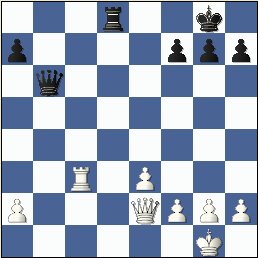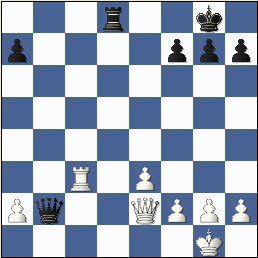All
the |
(Navigation bar
directly below.)
*******
© A.J. Goldsby, 2015.
(All rights reserved.)
****************
Click HERE
to see my
Chess Items.
****************
****************
Buy a book
from Amazon.com
(And help me out as well!)
****************
Click HERE
...
to see a list of the businesses that help to sponsor all of
my chess efforts.
Bernstein vs. Capablanca
Exhibition Game; Moscow, 1914.
This game is a continuing effort to find the best games of
chess, (for all the great players); ever played.
(See my "Best {All-Time} Game" page
for details.)
***
This is mostly a text-based page, with only two diagrams.
Therefore,
you will probably want ... or need a chess-board.
Click HERE to see an explanation of the symbols that I use in annotating a chess game.
Click HERE to replay this game ... on another website.
Click here to see a copy of my analysis.
Click HERE to see my video on this game.
<<
Frank Marshall once asked Capablanca what game he regarded as his (Capablanca's)
best. The reply was:
"It is difficult to say; so much depends on the point
of view. There are three possible types of best game --
a fine attack, a
brilliant defence, or a purely artistic treatment."
Marshall
then asked which game he considered best from the (purely) artistic point of
view, and Capablanca's answer was,
"I think my most finished and artistic
game was the one I played against Dr. Bernstein on February 4th,
1914." >>
--- From Irving Chernev's book: "The Golden Dozen."
Ossip
Bernstein (2675) -
Jose R. Capablanca (2750)
[D63]
Exhibition Game
Moscow, Russia; (Game # 1); 1914.
[A.J.G.]
***********************************************************************************
While 'just an exhibition' game, the mighty Capa considered this the finest game he ever played. (From an artistic point of view.)
The ratings are purely estimates. No reliable ELO exists for that period of time.
Sonas gives Capa as # 2 in the World, with a rating of 2735. (The # 2 player today is considerably higher, by at least 50 points.) Sonas gives Bernstein as # 10 in the World, with a rating of 2585. (In 2001, when I first did this game, the # 10 player was high-2600's. In 2003, the # 10 player is usually over 2700.)
***********************************************************************************
1.d4
d5; 2.c4 e6; 3.Nc3 Nf6; 4.Nf3 Be7; 5.Bg5 0-0; 6.e3 Nbd7; 7.Rc1 b6!?;
An early form of the "T.M.B. System."
[ More 'normal' at that time was the
continuation of:
7...c6!?;
8.Bd3, "+/=" etc. This is the <main line> of the
"Queen's Gambit Declined."
See MCO-14; or any good book on this particular opening. ]
8.cxd5!
exd5; 9.Qa4! Bb7!?;
Interesting ... and not at all
bad.
[ The more normal 'book'
continuation is:
9...c5!?;
10.Ba6!?, "+/=" with a slight edge to White.
S. Makarichev - Z. Sturua; Frunze, (3); 1985. ]
10.Ba6,
White plays to remove the B's.
[ Interesting was: 10.Bd3!?, which is probably slightly better for White. ]
10...Bxa6; 11.Qxa6 c5;
12.Bxf6!?, (Maybe - '?!') {Diagram?}
White gives up the Bishop, but
he does so in order to weaken Black's Pawn structure.
(This move has been criticized
by many Masters for prematurely surrendering this piece.)
[ Better is: >/=
12.0-0, "+/=" {D?}
and White holds a slight edge. ]
12...Nxf6;
13.dxc5 bxc5;
Capa now has 'hanging pawns.'
14.0-0
Qb6!; 15.Qe2!? c4!; (Really - '!!') {A
new idea?}
Chernev awards this an exclam.
Black cuts off the Queen and leaves a gaping hole at d4 for the White Knights ... but gets play against White's Queen-side. (initiative)
"Perhaps the most significant move of the whole game." - GM John Emms.
Capa is also violating his own advice that he set forth in books like his classic volume, "Chess Fundamentals." (Giving himself a backward pawn.)
Kasparov
praises this as a good move and a new and radical idea in chess.
(See Bertok - Fischer; Stockholm Interzonal, 1962.)
[ Interesting was: 15...Rad8!?; "~" ]
16.Rfd1
Rfd8; 17.Nd4 Bb4!;
The Bishop becomes aggressive.
(The base of Black's pawn chain here is d5. So the Knight on f6 guards this pawn. White's Knight on c3 - attacking this key pawn ... is probably more valuable than the Bishop in this position.)
'!' - Irving Chernev.
[ Or 17...Rab8!?; 18.Qf3!, "=" ]
White decides to rid himself of the b2-pawn ... which is nothing more than a target ... and give Black an isolated c-pawn as well.
18.b3!?
Rac8; 19.bxc4 dxc4; 20.Rc2!? Bxc3!;
21.Rxc3 Nd5!;
Black's piece activity is becoming more evident - and compensates for his structural problems.
(Black naturally asks the Rook to remove itself from in front of his passer.)
'!' - Irving Chernev.
'!' - GM Garry Kasparov.
Naturally,
White must retreat, if 22.RxP?, then simply 22...Nc3; wins an exchange.
22.Rc2
c3; ('!')
"The Black Pawn is now a source of great strength." -
Capablanca.
23.Rdc1
Rc5; 24.Nb3!? Rc6; 25.Nd4 Rc7!!;
Black declines the draw.
He also sets an incredibly deep trap for Bernstein.
'!' - GM Garry Kasparov.
[ After the moves: 25...Rc5;
26.Nb3 Rc6; 27.Nd4 Rc5;
28.Nb3,
"=" we have a draw by a 3-time repetition
of the position. ]
(White's
next move actually begins an extremely dubious concept.)
26.Nb5!? Rc5; 27.Nxc3!?, ('?')
White decides he may snap up the seemingly helpless c-pawn.
(Really
this move is an error ... and you could give it at least one question mark {?} ...
... some - like GM
J. Emms - have even given it two question marks.)
[ White has to play: 27.Nd4!?[], and pray that Capa cannot find a way to improve his position.
(I like ...Qf6 or ...Qg6!; both of which appears to give Black
a fairly solid edge. At least - '=/+') ]
The
next few moves are all forced.
27...Nxc3; 28.Rxc3 Rxc3; 29.Rxc3, (hmmmm)
{Diagram below.}
White has won a pawn, and it would seem Black's own weak
'home-row' (first rank) would prevent him from getting frisky or trying anything really cute.
*************************
*************************
So what is Capa's plan?
29...Qb2!!;
(Maybe - '!!!') (WOW!!!)
{See the
diagram just below.}
White Resigns.
(If 30.Qxb2?, then Black simply plays 30...Rd1#.)
Chernev points out that White has like 10 different ways to lose.
(Probably the two cutest are: Qe1, QxR/c3!!; or Rc2, Qb1+. Both of these continuations cost White an entire Rook. Also amusing is Qc2, Qa1+; Qc1, Rd1+!; which leads to a mate.)
*************************
*************************
"Bernstein
resigned gracefully. Playing even one more move would have been an anti-climax.
(Besides there is no reply to a thunderbolt.)" - Irving Chernev.
Many consider this Capa's best game, and the mighty player himself also considered it one of his best efforts.
***********************************************************************************
Capablanca
links - Here,
or here,
or here, or
here, or here,
or here.
(Chosen more or less at random.)
Click HERE to go to an on-line encyclopedia to learn more.
***********************************************************************************
Bibliography:
I have seen this game in print more times than I care to count. It is a classic
exploitation of a weak back-rank. But the main books I used to annotate this
game were:
#
1.) "THE GOLDEN DOZEN."
('The twelve greatest
chess players of all time.' Short bio's and some career highlights, then a small selection of that player's best
games.)
By Irving
Chernev. Copyright (c) 1976. Published by The Oxford
University Press. ISBN: # 0-19-217536-X
#
2.) "The Immortal Games Of Jose
Raul Capablanca," by (the
incomparable) Fred Reinfeld.
Copyright (c) 1942.
Published by Horowitz & Harkness; of New York, NY.
(USA)
#
3.) [The 'Mammoth Book' Of] "The World's
Greatest Chess Games," (The best that were ever played -
the top 100.)
by GM John Nunn,
GM John Emms, and FM Graham
Burgess. Copyright (c) 1998, by
the authors.
Published by Carroll
& Graf Books. (New York.) ISBN: #
0-7867-0587-6
---> As a Master, I
must say this is some of the best analysis I have ever seen, anytime
... anywhere.
(This game is also in "My Chess Career," by J.R. Capablanca.)
#
4.) Garry Kasparov on
"My Great Predecessors," (Part
I); by GM G.
Kasparov and D. Plisetsky. (et al)
Copyright (c) 2003, by
the author(s). Published by Everyman
Chess Books. (formerly Cadogan)
ISBN: #
1-85744-330-6
(For my review of this book, click here.)
***********************************************************************************
Copyright
(c) A.J. Goldsby I.
(First annotated in 1983.)
Copyright (c) A.J. Goldsby, 2003. All rights reserved.
(All chess games - code initially) Generated with ChessBase 8.0
0 - 1
This is a version of my game I developed just for my Geo-Cities web pages.
*******
Copyright (c) A.J. Goldsby I
Copyright (©) A.J. Goldsby, 1975 - 2014.
Copyright © A.J. Goldsby, 2015. All rights
reserved.
*******
Game
first posted: May, 2003. Final g/c version posted: August 28th,
2003.
Last {major} update: Saturday; October 25th, 2013.
Last edit/save on: 02/26/2015
.
Click HERE to return to my Home page.
Click HERE to return (or go) to my page on the "Best (All-Time) Chess Games" ever played.
Click HERE to return (or go to) my page on "Forgotten Players." (#1.)
Click HERE to go to (or return to) my page for "Annotated Games." (Number Two)
(Or press the "Back" button on your web browser.)
If you would like to contact me concerning this analysis, click here.
Copyright (c) A.J. Goldsby I

